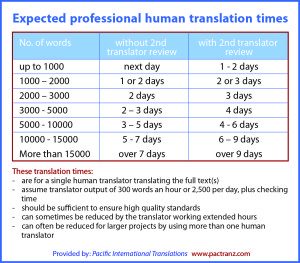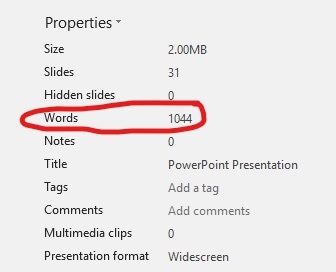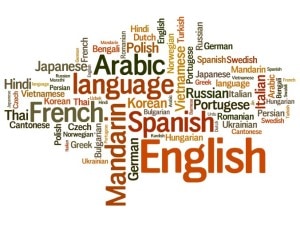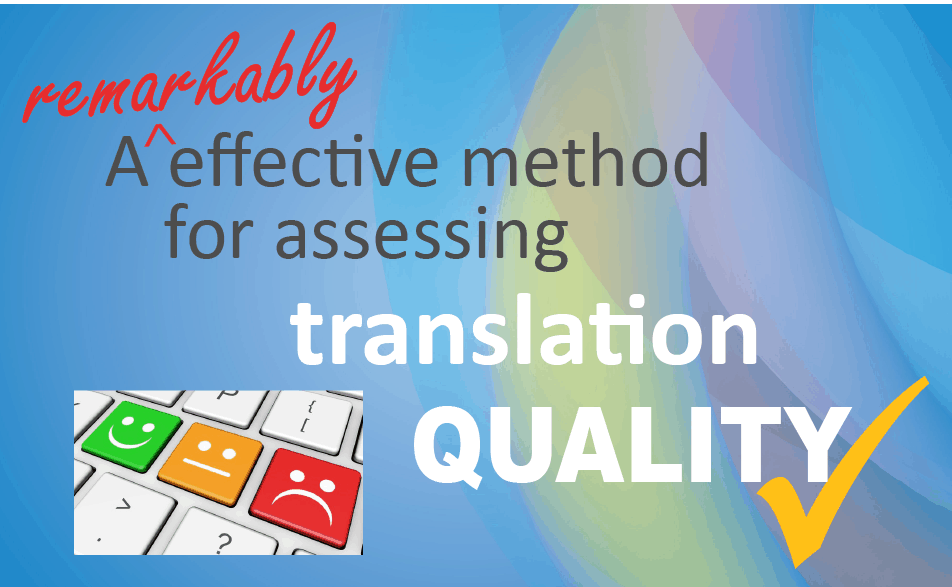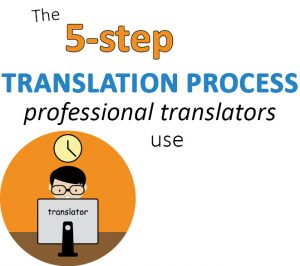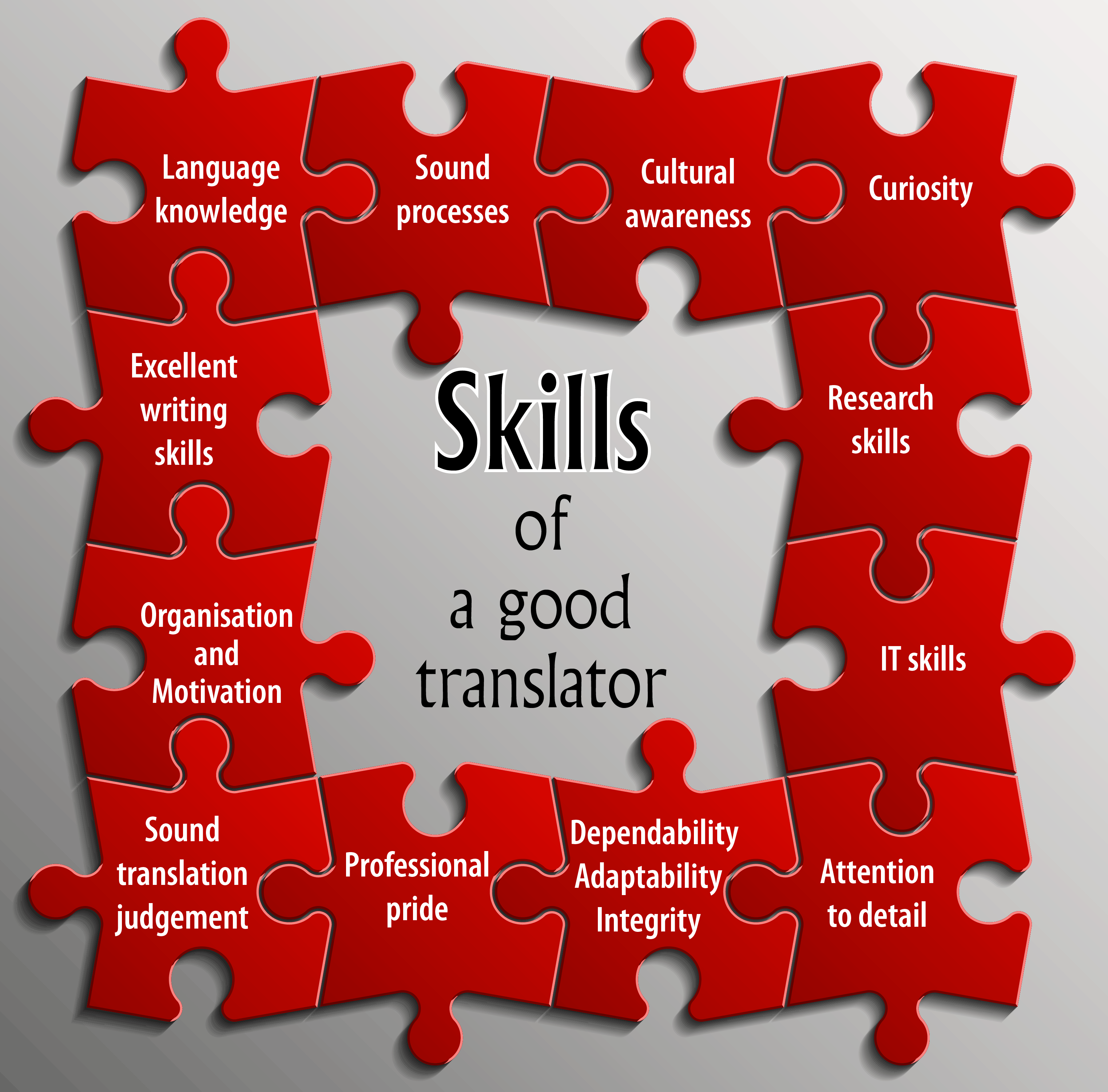The translation times suggested here will work for most business translation projects.
We’ve based them on realistic translation speed and output expectations for professional translators taking care to translate to a high standard.
Up to 1000 words: 1-2 days translation time
1000 – 3000 words: 2-3 days
3000 – 5000 words: 3-4 days
5000 – 10000 words: 4-6 days
10,000-15000 words: 6-9 days
Longer projects typically involve teams of translators, making it difficult to generalize on project translation times – see below for details.
You can download a pdf of these realistic translation turnaround times below.
Important:
These translation times:
– are for a single professional translator translating the full text(s)
– assume a translator speed / output of 300 words an hour and 2,500 words per day
– include time for translator self-review (essential to ensure high quality!)
– are for translations of professional standard
Read on for:
– the factors that affect translation times
– ways to reduce project turnarounds
– projects that will take longer
Or our slide show:
The 4 key factors that determine translation turnaround times
The time any translation project will take depends on 4 things.
1. How many words need to be translated?
Calculations of translation times always start with the word count of the text we’re translating.
That’s because it gives us the most reliable indication of the amount of work involved.
Note we use the number of words, not pages. That’s because the amount of text on individual pages, and therefore the time spent translating them, can vary considerably.
Here’s how to get the word count from your document:
Microsoft Word
It should be shown on the Status Bar at the bottom of the document:
If it isn’t, position your mouse over the bar, right click and select Word Count.
Note: This word count generally won’t include text in text boxes or inserted graphics.
Excel
Either copy and paste the text into Word, or save the file as a text file and open it in Word.
Then get the word count from the status bar in Word, as described above.
PowerPoint
Click on File at top left and it should be shown in the right hand column:
If it isn’t, click on Show all Properties at the bottom of that column.
This won’t include text in inserted graphics.
Pdf
Use a free word count program, or copy and paste into Word.
If you can’t select the text, you’ll need to count it manually, or use an OCR program and copy into Word.
Hard copy
Count manually or use an OCR program and copy into Word.
2. Assumed translation speed per hour and per day
Translator speeds and output vary enormously – anywhere from 200 to 500 words an hour and 1200 to 4000 words a day.
Factors affecting a translator’s speed include their experience, subject familiarity, translation review processes, and whether previous translations can be leveraged.
However, a realistic average speed for a professional translator producing quality translations is 300 words per hour, and a translation output of 2500 words per day.
A quick web search will reveal wildly different translator speed and output numbers.
Some translators even claim to produce 6 to 8 thousand words a day. Wow!
The highest numbers are frankly scary for their implications on translation quality. And the lower numbers are perhaps a little conservative for most projects.
We consider 300 words an hour and 2,500 a day a realistic expectation for a quality-focused, experienced human translator. Certainly professional translation companies will typically consider a translation speed of 2,000 words a day an absolute minimum from their professional translator employees over time. They would likely expect 2,500 and be pleased with 3,000.
Freelance translators though may well produce greater volume per day by working longer hours. Their work often comes in waves and they tend to want to make hay when the sun shines.
But translating for extended hours impacts quality
There is no doubt that quality is affected with longer hours worked.
This is because language translation involves intense mental concentration and is very taxing. In fact, many full-time freelance translators will only work 5 or 6 hours a day precisely because of this.

So a translator may well be able to produce a higher volume by working longer hours over a few days without affecting translation quality. However longer term it is difficult to do.
I’d definitely have my suspicions about anyone saying their translation speed is habitually 4,000 words or more a day.
I’d question how thorough their processes are and how much time they spend on checking for accuracy and improving their wording (see next section below). They would certainly need processes to mitigate the (virtually inevitable) drop-off in quality that comes with translating over an extended period.
Some translators might well be brilliant and produce consistently high quality at this translation speed. However I suspect most will favour quantity over quality. This means work that won’t be immune from the odd mistake and less than ideal wording.
Of course for certain purposes this level of quality might still be fine.
The one big proviso on these translation speed figures
These numbers assume there is little repeated or previously translated text in the documents being translated.
If the translator can use previous translations either as is or with only minor amendments for parts of the text, this will speed up the translation process and potentially knock some time off translation times.
Translation memory (TM) software is ideal for identifying identical and highly similar text repetitions (called 100% matches and fuzzy matches) and is widely used by translators.
3. Allow time for the translator to review his/her work
Professional translators will generally consider their first run through a text as only a draft translation. It’s not unusual for them to miss a nuance of meaning , or use wording that’s a little stilted and unnatural, or both these, in this first pass.

That’s why good translators will always allow time for thoroughly checking and revising their work. They’ll check they’ve correctly conveyed all meaning, and polish and refine their wording.
Ideally they’ll do this after a decent break to clear the mind so they approach the text again with fresh eyes.
We cover this in detail in our article on the the 5 step translation process professional translators use.
So, it’s not always a matter of just dividing the number of words by 300 or 2,500 to get the number of hours or days. It’s wise to allow a little extra time for a break and subsequent checking.
Best results tend to come from an overnight break and review the following day.
4. Is there a second translator review?
Often the translation process will include to a full second translator review of the translation.
The review can involve various possibilities but normally aims to pick up any inadvertent translator errors, check for translation accuracy, and further improve wording where needed.
We particularly recommend this for essential business documents where guaranteed accuracy and high quality of expression is vital.
Such a review is considered best practice and is prescribed in language translation Standards. It is what our company offers with our quality-assured translations and is an integral part of our overall translation quality assurance programme.
Our rule of thumb is to add 30% to translation times for the peer review component.
Putting all this together, we suggest the following guidelines for translation times:
Table of expected professional translation times
| No. of words | No 2nd translator review | With 2nd translator review |
|---|---|---|
| up to 1000 words: | next day | 1 - 2 days |
| 1000 – 2000 words: | 1 or 2 days | 2 or 3 days |
| 2000 – 3000 words: | 2 days | 3 days |
| 3000 - 5000 words: | 2 – 3 days | 4 days |
| 5000 - 10000 words: | 3 – 5 days | 4 - 6 days |
| More than 15000 words: | 5 - 7 days | 6 – 9 days |
| More than 15000 words: | over 7 days | over 9 days |
Download these turnaround times as a pdf
Ways to reduce translation turnaround times
There are really just two ways to reduce the overall time needed to translate a given text or set of materials:
- the translator works longer hours
- you use more than one translator
Working longer hours
This may well be possible in some circumstances.
However it does come with some risks, as we know translation quality can drop off markedly when translators tire.
The second option is definitely an option for longer projects.
Using multiple translators on the same translation project
Using more than one translator on longer texts will generally speed up the project turnaround time. For example, a 20,000 word text might take one translator 9 days, but take two translators just 5 days.
Note that in calculating translation times frames for a single project using multiple translators, it isn’t always just a matter of splitting up the documents and assuming the time frame for the longest component will be the time for the whole project.
That’s because for most materials care needs to be taken to ensure the translators have all translated key terms in the same way, and the writing style is consistent throughout the texts.
Depending on how the project is structured, this will generally imply a small amount of additional time.
Factors that will extend translation times
1. Projects involving more than one language
In multi-language translation projects, all languages can generally be translated at the same time. Thus overall translation times are often much the same as for a single language translation project.
However there is more administration required, so complex projects involving numerous files and/or languages may require a little extra time to reflect this.
There may also be issues around translation consistency across the languages.
For example you would want to be sure any difficult or key terms or concepts were handled in the same way by the translators in each language.
Again some additional time might be required to co-ordinate and confirm this.
2. When typesetting is required
Typesetting is the placing and formatting of text in a graphic design file. It will be required whenever files such as InDesign, Quark Express and Illustrator are involved.
It needs to be done by specialist foreign language typesetters familiar with the design and layout rules and conventions in the relevant language(s).
Typesetting won’t start until the foreign language translations are finalised, so will add time to any project. And in multi-language projects, individual languages may well be typeset consecutively and not concurrently.
Typesetting time can vary considerably. It will depend on text volume, layout, languages and the program(s) used. A page might take 5 minutes to typeset, or 35.
Giving an average time per page is therefore difficult. However many, and probably most, design files can be typeset at a rate of around 5 or 6 pages an hour. Proofing time needs to be added to this, as thorough checking and review of the artwork is vital.
Thus typesetting a 32 page brochure in a single language, and an 8 page brochure in five languages, might each add 2-3 days to the translation project time frame.
We’d recommend getting a separate time frame for any typesetting component as times can differ markedly from project to project.
Conclusion/Summary
1. The translation times in our table should work for most translation projects that don’t involve typesetting or significant repeated, highly similar or previously translated text. They assume typical human translation speed and productivity, and allow sufficient time for best practice quality control checks. Thus they are sufficient to produce translations of professional standard.
2. Turnarounds can sometimes be shortened by using multiple translators, or a single translator working extended hours. However translators often struggle to maintain quality when working long hours.
3. Conversely some projects may need more time. Examples would be when there is limited translator availability (especially in specialist fields or very low demand languages), or the complexity/technicality of text requires lengthy researching of terminology. And typesetting will add time to any project.
4. We’d suggest using these translation times as a rule of thumb and confirming precise timings with your translator or translation company before starting the project.
Let us quote for your next translation project!
We’ll deliver you high-quality work – guaranteed! Simply:
– use our translation quote form, or
– e-mail us the details
and we’ll be right back to you.
Be sure to jump on our mailing list!
You’ll get proven, highly practical and quick-read tips for achieving better translation results, direct to your inbox.
Great value for just 20 seconds of your time, once a fortnight. Sign up now, or read more here.
See the Key articles for clients list on our main blog page.
Or start with these:
What we mean by translation quality and a simple method for assessing it
The 5 step translation process professional translators use
The specialised skills needed for professional translation
Back to top | Pactranz blog | Pactranz home page

